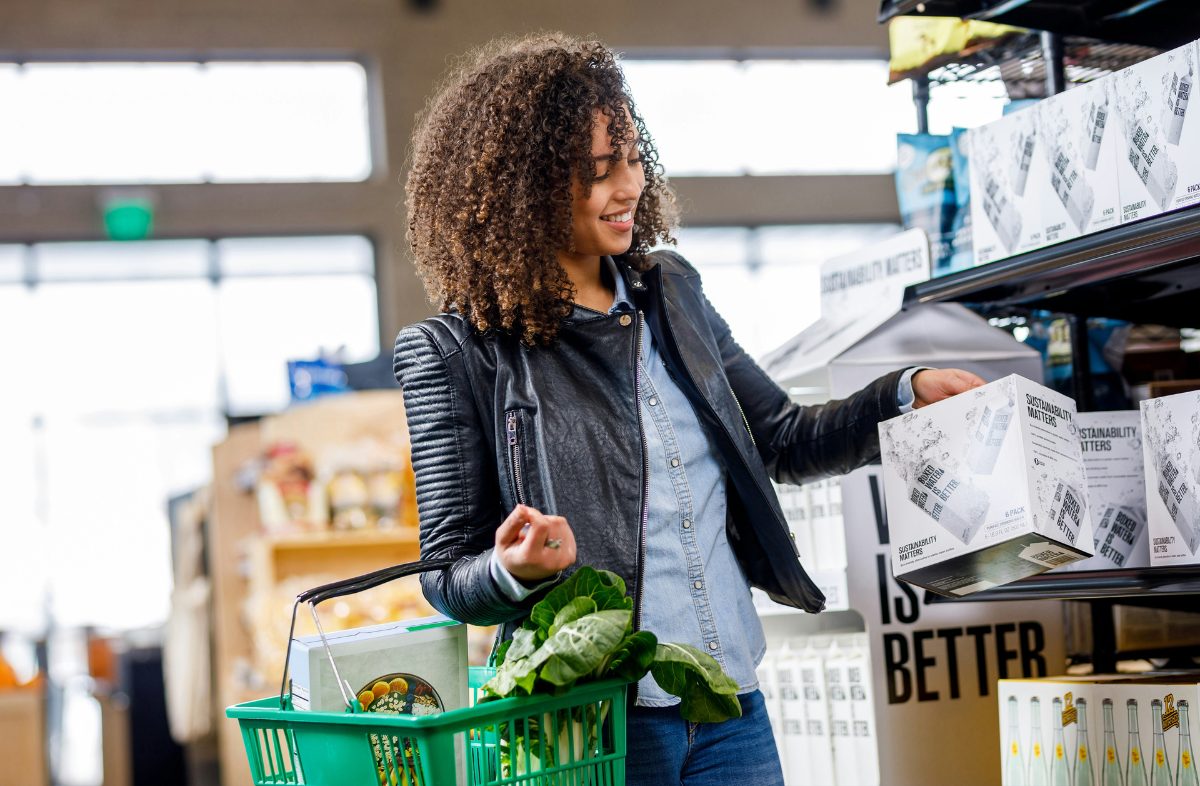
Photo by Boxed Water Is Better via Unsplash.
From Food Town to Bloom and back, Food Lion’s history is marked with plenty of twists and turns.
With around 1,100 locations spread across 10 states — with about half of those located in North Carolina — chances are you’re familiar with grocery giant Food Lion. You may prefer Harris Teeter, Lowe’s, or even the newly arrived Wegmans, but surely you recognize that black-and-blue lion logo (more on him in a second).
With humble beginnings and a 57-year history that’s filled with twists, turns, controversies, and successes, we’re willing to bet there’s a lot about Food Lion that you don’t know.
We’ve compiled a list of eight trivial truths that have marked the long path leading to the company’s current role as one of North Carolina’s most popular grocery chains.

Photo courtesy of Virginia Retail/CC BY 2.0.
1. The Founding of Food Town
What is now known as Food Lion began in 1957 as a one-store operation in Salisbury operating as Food Town. Founder Ralph W. Ketner expanded to seven locations over the next decade, but it was during the late 1960s after he introduced his LFPINC (Lowest Food Prices in North Carolina) policy that he truly started to see business skyrocket.
Introduced in 1968, Ketner’s cost-cutting theory was seen as risky at the time but today is viewed as revolutionary. The idea is based on a simple enough concept: lower prices across the store and sell more products, leading to higher products. Or as Ketner put it, “Make five fast pennies [rather] than one slow nickel.” The idea worked, and by 1991 when Ketner retired, the chain had 800 locations.
At one point, Rowan County was reported to have the most millionaires per capita in the country (31) thanks to the high returns enjoyed by anyone who invested in Ketner’s vision early on.
2. Food Lion emerges
With expansion came territorial wars — not quite the ones you might see in your favorite gangster flick, but ominous nonetheless. As Food Town expanded into Virginia, they encountered pushback from several stores named Foodtown in Richmond, then nearly 100 independent but affiliated stores called Food Town waiting for them in Maryland. It became clear that they’d need a new name — one that was less common.
The Delhaize Group grocery company acquired the Food Town chain in 1974, and Ketner saw that the Belgium-based business had a lion in its logo. He also calculated that, because changing a Food Town sign to a Food Lion sign would require the changing of just two letters and the movement of another, that would be the way to go.
On December 12, 1982, Ketner announced the name change to “Food Lion,” and by the end of March 1983, all stores had been rebranded.

Photo courtesy of Ntropolis/CC BY-SA 3.0.
3. Leo the Food Lion and slogan issues
Food Lion has always been big on branding, to the point where it has gotten the chain in trouble at times. Always the one for a catchy slogan, Ketner found himself in court at times due to the claims in his marketing. In the early 1980s, when it was still Food Town, the company was sued for using slogans that allegedly misrepresented its competitors and misinformed the public concerning the extent of its low prices. A court ruled in the early 1980s that Food Town must change its slogan from “Lowest Food Prices” to “Low Food Prices.”
What hasn’t garnered controversy has been Food Lion’s recognizable logo and mascot, which was unveiled on Jan. 17, 1997, as Leo the Food Lion. You might even get to stumble upon Leo himself at certain community events, like Taste of Charlotte, where he’ll be hanging out at the Food Lion Front Porch all day on June 9.
4. Not ready for primetime
The legal battles of the 1980s were nothing compared to what Food Lion would face in the following decade. Entering the ’90s as the fastest-growing grocery chain in the United States, a November 1992 report on the popular national news show Primetime Live brought that all to a screeching halt.
Footage showed Food Lion employees mishandling meat and working in unsanitary conditions. The report led to a 10% drop in sales for the company and, perhaps more critically, halted its plans for expansion into other parts of the country. In the end, the report proved to be the death knell for newly opened locations in Texas and Oklahoma while leading to the cancellation of plans for expansion in Missouri, Kansas, and Illinois.
5. Ill-fated rebrandings
Since entering the new millennium, Food Lion has attempted to launch two spin-off brands of sorts — a high-end grocery chain called Bloom and a more affordable chain called Bottom Dollar Food.
Launched in the Charlotte area in May 2024, Food Lion’s upscale concept Bloom was based on market research that led designers to implement a slightly unconventional layout that they believed would maximize shopper convenience (milk in the front, for example). Though the concept did not make it 10 years, with all Bloom stores rebranding back to Food Lion by January 2012, it did serve as an early testing ground for some concepts that grocery shoppers are all too familiar with today including self-checkout lines and the use of touch-screen computers.
Conceptualized at the same time as the Bloom branding, the first Bottom Dollar Food store opened in High Point in 2005. The model aimed to curtail costs for customers by allowing them to bag their own groceries and implementing alternative stocking methods such as placing cases of products directly on the shelves rather than merchandising them. The branding was also killed in January 2012 as part of the same restructuring that ended Bloom.

Public Domain photo.
6. Let’s get local
Today, Food Lion stores experience more than 10 million transactions every week, offering more than 26,000 products to customers. The chain also prides itself on supporting as many local farmers and producers as possible through its Local Goodness program. At each store within their 10-state footprint, staff members specially mark a wide selection of local products from sauces and snacks to meat, seasonal produce, and everything in between.
Some examples of beloved local companies from around the state that Food Lion carries loyally are Neese’s Sausage (Greensboro), Ruth’s Salads (Charlotte), and Mt. Olive Pickles (it’s in the name), among others. You can check out the full list here.
7. Giving back to the community
In 2014, Food Lion launched its Food Lion Feeds program to help address food insecurity, which saw a 31% increase in 2022. Food Lion Feeds does so by providing product, financial, and equipment donations; disaster relief and recovery efforts; investing in capital campaign support for feeding agencies; and volunteer hours by associates. Upon its launch a decade ago, the company committed to donating 1.5 billion meals by 2025.
In 2019, Food Lion Feeds launched its annual Orange Bag campaign, which has helped to provide more than 25 million meals through the sale of specially marked orange bags and cash donations.
“Every cash donation and orange bag purchase make a lasting impact to help nourish our neighbors,” said Kevin Durkee, manager of Food Lion Feeds, following this year’s campaign, which ran from Feb. 28 to March 19. “Working in collaboration with our partner food banks, we are honored to support their efforts to address food insecurity. We are committed to doing our part because everyone deserves access to nutritious food.”
8. Groceries at your doorstep
The latest project for Food Lion? Home delivery. On May 2, the company launched its first-ever delivery service for customers in seven states: Delaware, Kentucky, Maryland, Pennsylvania, South Carolina, Tennessee, and West Virginia. Luckily for us in the Old North State, however, we didn’t have to wait long to be included. As of May 9, North Carolina, Georgia, and Virginia have been added to the mix.
So how does it work? Customers in the delivery zip codes that have been included in the early launch can use the Food Lion To Go website or download the Food Lion To Go app to confirm availability and place orders. Powered by Instacart, allows customers to experience the same low prices and fresh food items without having to leave their homes. The online service allows customers to place an order and have their groceries delivered right to their front door.
If you’re not included in the long list of zip codes where this service is currently available, Food Lion plans to continue expanding the service area in the months to come.
This article first appeared on Good Info News Wire and is republished here under a Creative Commons license.
READ MORE: Explore the 9 cheesemakers of the WNC Cheese Trail

11 NC chefs dish out advice & inspiration for holiday meals
Need inspiration for your holiday meals? We asked 11 North Carolina chefs to share their go-to dishes and traditions for this celebratory season....

Get your Thanksgiving turkeys at these 9 Western NC farms
These nine farms in western North Carolina offer pasture-raised turkeys ready for Thanksgiving. It will be a somber holiday season in western North...

Listeria recall grows to 12 million pounds of meat and poultry, some of it sent to US schools
By JONEL ALECCIA AP Health Writer A nationwide recall of meat and poultry products potentially contaminated with listeria has expanded to nearly 12...

The 5 best BBQ joints in Winston-Salem, according to Reddit
Get your napkins ready and feast on the best BBQ in Winston-Salem. When it comes to BBQ, Winston-Salem has a mouthwatering reputation that can't be...







